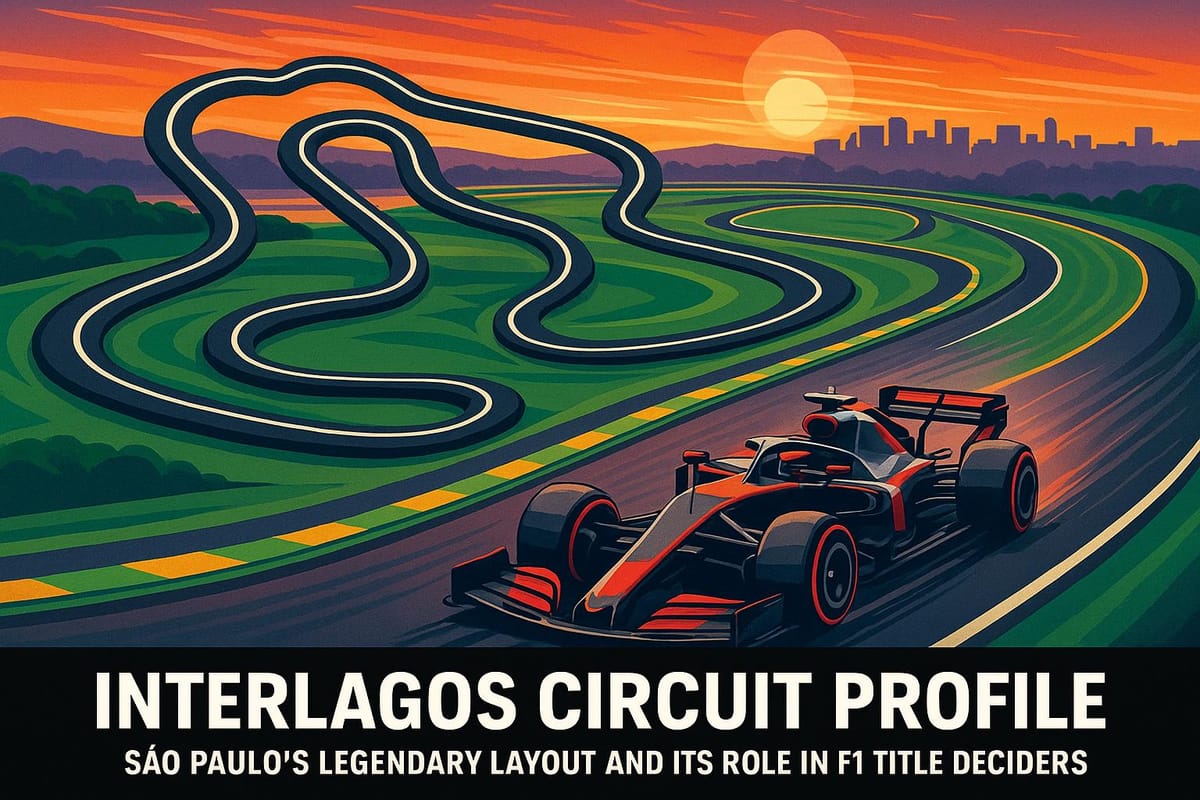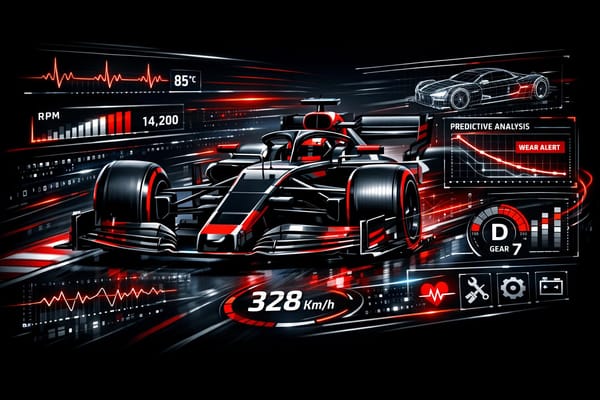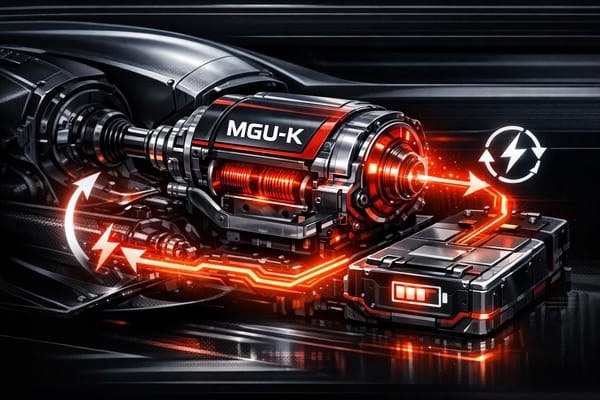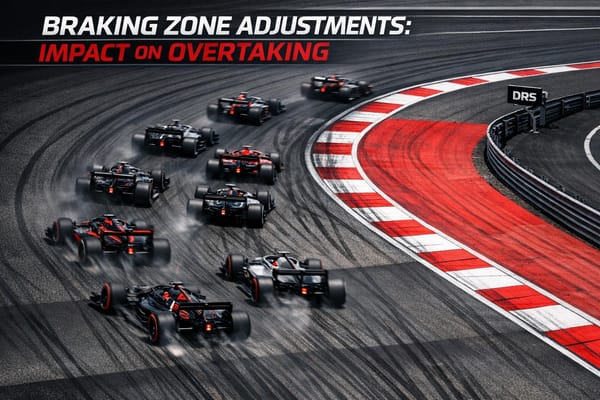Interlagos Circuit Profile: São Paulo’s Legendary Layout and Its Role in F1 Title Deciders
Explore the unique challenges and legendary moments of the Interlagos Circuit, a key venue for thrilling Formula One championship battles.

The Interlagos Circuit in São Paulo, Brazil, is one of Formula One's most iconic tracks. Known for its counterclockwise layout, sharp elevation changes, and challenging corners, it has been the stage for unforgettable championship battles. With unpredictable weather and passionate fans, it creates drama like no other venue.
Key highlights:
- Opened: 1940, with a 4.946-mile original layout.
- Current Length: 2.677 miles (4.309 km).
- Famous Corners: Senna S, Descida do Lago, Subida dos Boxes.
- Weather: Sudden rainstorms and temperature swings.
- Historical Moments: Decisive races in 2007, 2008, and 2012.
Interlagos combines technical challenges with high-stakes racing, making it a favorite for drivers and fans alike. Its legacy continues as a cornerstone of F1, blending history with modern updates to meet the sport's demands.
Interlagos F1 Circuit History and Onboard (old layout)
Track Features and Technical Challenges of Interlagos
Interlagos is renowned for its demanding nature, testing both drivers and engineers with its unique layout and technical hurdles. The circuit's rolling terrain and diverse corner profiles create a challenging racing environment that's unlike any other on the F1 calendar.
Track Layout and Key Corners
The 2.677-mile (4.309-km) counter-clockwise circuit at Interlagos is a true test of stamina and precision over 71 laps. Its undulating surface, combined with a 141-foot (43-meter) elevation change packed into a short distance, pushes drivers to their physical and mental limits. These rapid transitions demand split-second decision-making and exceptional car control.
The track's 15 corners offer a mix of challenges. The Senna S (Turns 1 and 2) kicks off the lap with a downhill right-left combination, creating one of the best overtaking zones on the circuit due to its intense braking demands. Turn 4, known as Descida do Lago, provides another opportunity for overtaking, as drivers navigate natural bumps and undulations that force constant adjustments to their racing lines. One of the most grueling sections is Subida dos Boxes (Turn 14), where a steep 10% gradient tests both engines and power units as drivers power uphill toward the main straight. This uphill section, combined with the circuit's overall undulations, not only challenges driver precision but can also strain the underbody of modern F1 cars. Teams must carefully balance aerodynamic efficiency with mechanical reliability to handle these stresses.
Adding to the action, Interlagos features two DRS zones - one on the main straight and another on the back straight (Reta Oposta) - which aid overtaking. However, the natural layout of the track already provides plenty of opportunities for wheel-to-wheel battles.
Impact on Strategy and Car Setup
Interlagos requires a well-rounded car setup to handle its mix of slow corners, high-speed straights, and abrupt elevation changes. Teams often aim for a neutral aerodynamic balance, slightly increasing front wing settings to reduce understeer in the slower sections while maintaining top-end speed for the long straights. The elevation shifts call for softer suspension settings to ensure stability during transitions.
Tire management is another critical factor. As a front-limited circuit, Interlagos causes faster wear on the front tires. Teams typically lower tire pressures and tweak differential settings to minimize wheel spin and oversteer. On the downforce scale, the circuit demands a moderate setup - around 4 out of 5 - striking a balance between cornering grip and straight-line speed.
The unpredictable weather adds another layer of complexity, requiring teams to remain flexible and adaptable with their strategies.
Weather Conditions at Interlagos
Interlagos is notorious for its unpredictable weather, which can dramatically alter race conditions in an instant. Sudden rain showers, ranging from light drizzles to heavy downpours, keep teams and drivers on their toes. Temperatures during race weekends can swing between 41°F (5°C) and 108.5°F (42.5°C), with cockpit temperatures soaring to a stifling 140°F (60°C). These fluctuations directly affect tire performance, engine cooling, and overall car behavior.
In hotter conditions, reduced track grip accelerates tire wear, while cooler weather makes it harder to bring tires up to their optimal temperature. When rain hits, the circuit's elevation changes and natural drainage create varying grip levels across different sections, forcing drivers to constantly adjust their braking points and racing lines. Max Verstappen reflected on this challenge, saying:
"Growing up in Belgium and Holland, it rains a lot. So, we never like turned around when it suddenly started raining. We would put the rain tires on and we would go and practice and that just helps a lot. You get a lot more understanding of what you have to do when it rains." – Max Verstappen
To cope with these conditions, teams often have to compromise their setups, prioritizing adaptability over optimal performance in any single weather scenario. Balancing airflow and energy output becomes a dynamic challenge, especially when the weather changes without warning.
Interlagos in F1 Championship Battles
Interlagos has firmly established itself as a legendary stage for Formula One championship drama. Its tricky layout, unpredictable weather, and late-season scheduling have consistently created nail-biting moments where titles are decided in the final laps. Let’s dive into some of the most unforgettable championship-deciding races at this iconic venue.
Championship-Deciding Races
Interlagos has a long history of delivering high-stakes finales, and few races capture this better than the 2008 Brazilian Grand Prix. Lewis Hamilton entered the race needing a fifth-place finish to secure his first championship, while Felipe Massa sought a heroic home victory. A sudden rainstorm in the final laps caused chaos, and Timo Glock, running fourth on dry tires, struggled for grip. Hamilton seized the moment, overtaking Glock at the very last corner to clinch the title. Martin Brundle’s astonished commentary still echoes in fans’ memories:
"Is that Glock?!"
Fast forward to the 2012 Brazilian Grand Prix, another unforgettable showdown. Sebastian Vettel’s title hopes seemed dashed after an early spin, but he clawed his way back to finish sixth, enough to edge out Fernando Alonso and claim his third consecutive championship.
The 2007 season finale also delivered high drama. Kimi Räikkönen entered the race with a seven-point deficit but emerged victorious, flipping the standings to secure his first and only title.
Even in recent years, Interlagos remains a stage for pivotal moments. The 2024 São Paulo Grand Prix saw Max Verstappen start from 17th position and storm through the field to claim victory, extending his championship lead. Reflecting on the race, Verstappen said:
"The win was incredibly important because I was expecting to lose points in the championship. Now, I just want clean races. And I am not thinking about clinching the title in Vegas."
Why Interlagos Delivers Drama
A unique combination of factors makes Interlagos a magnet for championship-deciding races. Its counterclockwise layout, sudden weather changes, and high safety car likelihood (86% for a full safety car, 43% for a virtual safety car) can turn a race upside down in seconds. Drivers also face physical challenges, as the track’s layout forces their necks to endure forces in an unusual direction. Add to that the sharp elevation changes and demanding corners, and you’ve got a recipe for chaos and heroics alike.
Strategy plays a massive role too. Pit stops at Interlagos are especially critical - losing roughly 20.83 seconds in the pits can make or break a race. These elements have shaped countless title-deciding moments, as seen in the table below.
Memorable Championship-Deciding Races
| Year | Champion | Key Moment |
|---|---|---|
| 2007 | Kimi Räikkönen | Overcame a seven-point deficit entering the final race. |
| 2008 | Lewis Hamilton | Snatched the title by overtaking Timo Glock at the final corner during a late rainstorm. |
| 2009 | Jenson Button | Secured the championship for Brawn with a brilliant recovery drive from 14th on the grid. |
| 2012 | Sebastian Vettel | Recovered from an early spin to finish sixth and claim his third consecutive championship. |
As Ayrton Senna once said:
"there could only be one result"
Whether it’s last-minute overtakes, strategic gambles, or masterful recoveries, Interlagos has solidified its place as one of Formula One’s most thrilling and decisive circuits.
Team Strategies and Technical Changes at Interlagos
F1 teams are constantly refining their strategies to tackle the unique challenges presented by Interlagos. With its steep elevation changes, unpredictable weather, and technical demands, the circuit pushes engineers to find the perfect balance between performance and reliability.
Technical Developments at Interlagos
Sitting at an altitude of 2,625 feet (800 meters), Interlagos presents a unique challenge: thinner air reduces engine power and aerodynamic efficiency by about 1.6%. To counter this, teams increase turbocharger speeds by approximately 2,000 rpm while ensuring the engines remain reliable.
The circuit demands a careful trade-off between downforce for the slower corners and top speed for the straights. For example, the main straight stretches 1,230 meters and takes around 14.6 seconds to traverse, while the back straight between Turns 3 and 4 spans 820 meters. With cars running at full throttle for about 70% of the lap, finding the right aerodynamic setup is critical.
DRS (Drag Reduction System) also plays a key role here. On the main straight, DRS can add roughly 15 km/h to the car's speed, while on the back straight, the gain is slightly lower at around 13 km/h, depending on the car's setup.
Suspension tuning is another area of focus. Teams use soft suspension settings and low on-throttle differentials to reduce wheel spin and oversteer in the circuit’s slower corners. Additionally, front wing configurations are adjusted to provide more downforce in longer, slower corners, helping drivers maintain control through the track’s elevation changes.
Weather plays a massive role at Interlagos, and teams now rely heavily on advanced weather models and real-time data to guide pre-race simulations and tire strategies. This has become a game-changer, allowing teams to better prepare for the circuit's famously unpredictable climate.
Response to Circuit Updates
Recent updates to the track surface have added another layer of complexity. While resurfacing has improved overall grip, bumps - especially at Turn 4 - continue to challenge teams. To counteract this, teams have increased ride heights to avoid bottoming out, which can compromise diffuser performance. These adjustments highlight the balance between embracing new track features and managing their quirks.
Brake configurations have also been fine-tuned to suit the circuit's demands. Since braking accounts for only 17% of lap time, teams shift brake bias toward the rear to maximize efficiency through the track’s gentle braking zones.
Turn 12, also known as Juncao, has become a focal point for setup optimization. This corner is critical for maintaining speed onto the main straight, and teams have worked to improve traction at its exit by fine-tuning suspension geometry and differential settings.
Weather unpredictability remains one of Interlagos’ defining traits. Thanks to advancements in real-time weather tracking, teams can now respond to sudden changes with greater precision, making smarter decisions on tire selection and race strategy.
"The Brazilian weekend usually provides spectacular action...extremely changeable weather, make the outcome of the Grand Prix uncertain and hard to predict." – Formula1.com
From recalibrating car setups to leveraging cutting-edge weather technology, teams have turned Interlagos into a venue where performance can be optimized rather than merely managed. These ongoing technical and strategic developments ensure that the circuit remains one of the most challenging and rewarding stops on the Formula One calendar.
Interlagos in Modern F1
A Beloved Circuit for Drivers and Fans
Interlagos stands out as one of the most loved circuits in Formula One today. Its legendary track design and unpredictable weather create the perfect recipe for edge-of-your-seat racing. The counterclockwise layout, combined with its rolling terrain, naturally encourages overtaking and keeps strategy at the forefront. But what truly sets Interlagos apart is the electric atmosphere brought by Brazilian fans. Their energy and enthusiasm turn the race weekend into a celebration, making every event unforgettable. And then there's São Paulo's November weather - temperatures swinging between 62°F and 77°F, with sudden rainstorms - adding an extra layer of unpredictability to the racing action. While its rich history draws admiration, Interlagos continues to evolve, keeping pace with the demands of modern F1.
Preserving Tradition, Embracing Progress
Interlagos seamlessly weaves its storied past with the advancements of modern racing. Over the years, the circuit has undergone significant updates to meet F1's evolving standards. A major pit lane redesign in 2014 and the addition of high-intensity night lighting in 2018 have brought the track up to date without losing its classic appeal. Improvements like expanded run-off areas at critical turns such as the "Senna S" and Curva do Sol not only enhance safety but also elevate the viewing experience for fans and broadcasters alike. With its contract secured until 2030, Interlagos remains a cornerstone of the F1 calendar, blending its deep motorsport heritage with the ever-changing landscape of the sport.
Why Interlagos Remains a Legendary F1 Venue
Interlagos holds a special place in Formula One history, thanks to its demanding layout, rich history, and electrifying atmosphere. Spanning 2.677 miles, the track's counterclockwise design - something rare among top-tier international circuits - sets it apart and delivers a distinct challenge for drivers and teams alike.
The circuit's natural terrain is another defining feature. Built on São Paulo's hilly landscape, it boasts dramatic elevation changes that push both drivers and their cars to the limit. This old-school design tests engine performance and forces teams into making split-second strategic calls that can make or break championship hopes.
Adding to its unpredictability is the weather. Interlagos is known for its rapidly changing conditions, where rain showers can appear out of nowhere, throwing race strategies into chaos and creating unforgettable moments during title-deciding races.
Interlagos has also been the backdrop for some of Formula One's most emotional and pivotal moments. Its role in shaping championship outcomes has cemented its place in the sport’s lore, making it a fan favorite year after year.
And then there’s the crowd. Brazilian motorsport fans are among the most passionate in the world, and their energy transforms every race weekend into a celebration of Brazil’s deep connection to Formula One.
With its contract secured through 2030, Interlagos continues to blend tradition with relevance, proving that a classic circuit can thrive in the modern F1 era. Its ability to deliver unforgettable races ensures its status as one of the sport’s most iconic venues.
FAQs
How does the unpredictable weather at Interlagos affect Formula One race strategies and results?
The weather at Interlagos is anything but predictable, and it plays a huge role in shaping the drama and strategies of Formula One races. Sudden downpours, shifting track temperatures, and rapidly changing conditions keep teams on their toes, often forcing split-second decisions about tires and pit stops. These unpredictable elements can trigger safety cars, bold strategy calls, and surprising race outcomes.
For drivers and teams, adapting to a wet or drying track is a true test of skill and quick thinking. Over the years, this unpredictability has led to some of the most thrilling races in F1 history, packed with daring overtakes and unexpected podium finishes. It’s no wonder Interlagos has earned a reputation as a fan favorite, offering high-stakes action every time.
What are the main technical challenges teams face when preparing their cars for the Interlagos Circuit?
Teams face a host of challenges when preparing their cars for the Interlagos Circuit. Sitting at roughly 2,600 feet above sea level, the track's high altitude means thinner air, which directly impacts aerodynamics and engine performance. To counter this, teams need to tweak engine mapping to make up for the reduced air density and ensure optimal power delivery.
The track itself is a complex puzzle, combining elevation changes, long straights, and tight corners. This variety demands a finely tuned suspension setup to strike the right balance between grip and stability. Adding to the difficulty is the track's notoriously bumpy surface, which makes precision adjustments essential for consistent lap times. On top of that, Interlagos runs in an anti-clockwise direction, placing extra physical strain on drivers and requiring meticulous car setup to manage tire wear and lateral forces.
All these elements make Interlagos a tough but rewarding challenge, where success hinges on mastering the interplay between power, aerodynamics, and mechanical grip.
Why is the Interlagos Circuit known for deciding so many Formula One championships?
The Interlagos Circuit has earned its legendary status in Formula One, thanks to its thrilling mix of high-speed straights, sharp turns, and dramatic elevation changes that push both drivers and their cars to the limit. What truly sets this track apart, though, is its unpredictable weather - sudden downpours can turn the tide of a race in an instant, leading to unforgettable moments and surprising results. Since the 1970s, this iconic venue has been the backdrop for countless decisive races, making it a stage where championships are often clinched - or heartbreakingly lost.
Related posts
- Albert Park Uncovered: The History, Evolution, and Challenges of the Australian Grand Prix Circuit
- Suzuka’s Legacy: How Japan’s Iconic Figure-8 Circuit Became a Driver Favourite
- Monza’s Temple of Speed: The Fastest Track in F1 and Its Unmatched Heritage
- Circuit of the Americas: The Best of the Best in One Track - A Deep Dive into COTA’s Design




